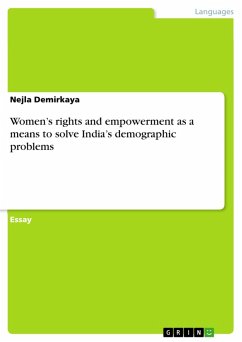Essay from the year 2012 in the subject Indology, grade: 2,0, University of Göttingen (Centre for Modern Indian Studies), course: Sex and Society: The Anthropology of Reproduction in India and the US, language: English, abstract: India suffers from two crucial demographic crises that not only endanger the country's political stability but also the lives and health of millions of its inhabitants: Overpopulation and gender imbalance. Both demographic phenomena are highly interconnected, yet they move in opposite directions: While overpopulation is going to remain a problem for the coming decades, recent developments give reason to hope for a stationary population, provided that fertility rates on state level either remain as they currently are or decline even further. Gender imbalance, however, continues to worsen in large parts of India. The protection of women's rights and the enhancement of their social and economic status are given utmost priority in the global battle against overpopulation and anti-female discrimination; many scholars argue that these may even be the single most important steps towards creating peaceful and just conditions for everybody. But can there be a panacea for the population problems of a country as complex and diverse as India? This essay attempts to show that women's rights and empowerment have partially already proven to be the key solution, although it can unfold its potency only in conjunction with further factors and as an accompaniment of social developments that are often culturally and regionally specific.
Dieser Download kann aus rechtlichen Gründen nur mit Rechnungsadresse in A, B, BG, CY, CZ, D, DK, EW, E, FIN, F, GR, HR, H, IRL, I, LT, L, LR, M, NL, PL, P, R, S, SLO, SK ausgeliefert werden.









